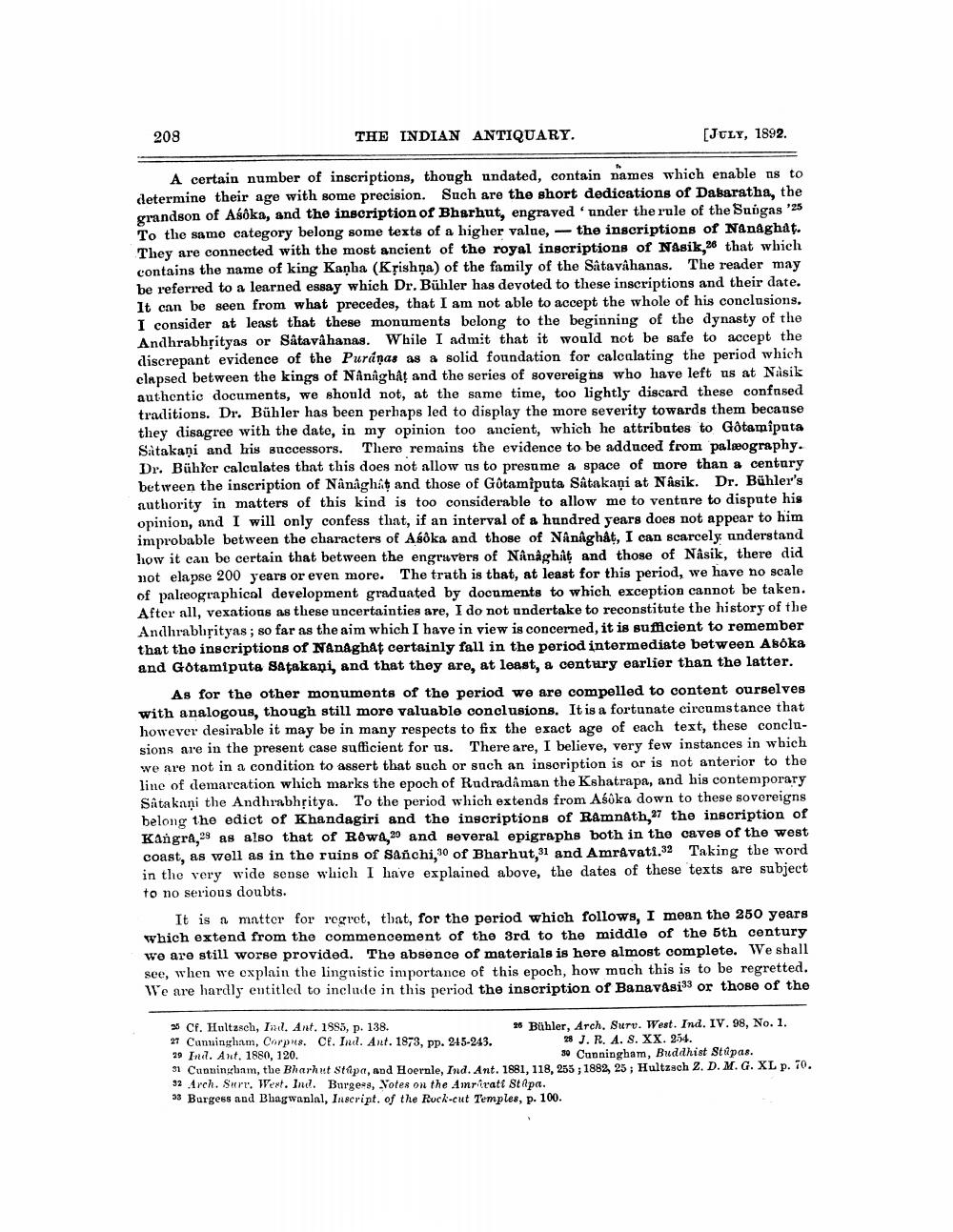________________
208
THE INDIAN ANTIQUARY.
[JULY, 1892.
A certain number of inscriptions, though undated, contain names which enable as to determine their age with some precision. Such are the short dedications of Dabaratha, the grandson of Asoka, and the inscription of Bherhut, engraved under the rule of the Sungas '25 To the same category belong some texts of a higher value, - the inscriptions of Nanaghåt. They are connected with the most ancient of the royal inscriptions of Nasik,26 that which contains the name of king Kanha (Krishna) of the family of the Satavahanas. The reader may be referred to a learned essay which Dr. Bühler has devoted to these inscriptions and their date. It can be seen from what precedes, that I am not able to accept the whole of his conclusions. I consider at least that these monuments belong to the beginning of the dynasty of the Andhrabhřityas or Satavahanas. While I admit that it would not be safe to accept the discrepant evidence of the Puranas as a solid foundation for calculating the period which clapsed between the kings of Nânaghat and the series of sovereigns who have left us at Nasik authentic documents, we should not, at the same time, too lightly discard these confused traditions. Dr. Bühler has been perhaps led to display the more severity towards them because they disagree with the date, in my opinion too ancient, which he attributes to Götamipata Satakani and his successors. There remains the evidence to be adduced from palæography. Dr. Büh'er calculates thnt this does not allow us to presume a space of more than a century between the inscription of Nânaghat and those of Götamiputa Satakaņi at Nâsik. Dr. Bühler's authority in matters of this kind is too considerable to allow me to venture to dispute his opinion, and I will only confess that, if an interval of a hundred years does not appear to him improbable between the characters of Asoka and those of Nánåghat, I can scarcely understand how it can be certain that between the engravers of Nânâghat and those of Nâsik, there did mot elapse 200 years or even more. The trath is that, at least for this period, we have no scale of paleographical development graduated by documents to which exception cannot be taken. After all, vexations as these uncertainties are, I do not undertake to reconstitute the history of the Andhrabhsityas; so far as the aim which I have in view is concerned, it is sufficient to remember that the inscriptions of Nanaghat certainly fall in the period intermediate between ABóka and Götamiputa Satakani, and that they are, at least, & century earlier than the latter.
As for the other monuments of the period we are compelled to content ourselves with analogous, though still more valuable conclusions. It is a fortunate circumstance that however desirable it may be in many respects to fix the exact age of each text, these conclusions are in the present case sufficient for us. There are, I believe, very few instances in which we are not in a condition to assert that such or sach an inscription is or is not anterior to the line of demarcation which marks the epoch of Rudradaman the Kshatrapa, and his contemporary Satakani the Andhrabhřitya. To the period which extends from Asoka down to these sovereigns belong the edict of Khandagiri and the inscriptions of Ramnath,27 the inscription of Kangra, 29 as also that of Rów4,29 and several epigraphs both in the caves of the west coast, as well as in the ruins of Sanchi,30 of Bharhut, 31 and Amravati.32 Taking the word in the very wide sense which I have explained above, the dates of these texts are subject to no serious doubts.
It is a matter for regret, that, for the period which follows, I mean the 250 years which extend from the commencement of the 3rd to the middle of the 5th century We are still worse provided. The absence of materials is here almost complete. We shall see, when we explain the linguistic importance of this epoch, how much this is to be regretted, We are hardly entitled to include in this period the inscription of Banav&si33 or those of the
25 Cf. Hultzsch, Iul. Ant. 1955, p. 138.
26 Bühler, Arch. Suru. West. Ind. IV. 98, No. 1. 27 Canningham, Corpus. Cl. Ind. Ant. 1873, pp. 245-243.
28 J. R. A. S. XX. 254. 29 Ind. Ant. 1880, 120.
50 Canningham, Buddhist Stapas. 51 Cunningbam, the Bharhut Stapa, and Hoernle, Ind. Ant. 1881, 118, 255; 1882, 25; Hultzsch 2. D.M.G. XL p. 70. 32 Arch. Surt, Wext. Inuel. Burgess, Yoter on the Amriratt Stripe. 33 Burgess and Bhagwanlol, Inscript. of the Rock-cut Temples, p. 100.




